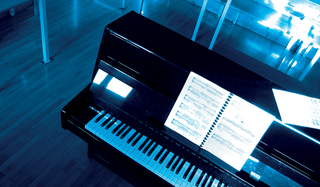
By Hagen Höpfner
Musicians with absolute pitch can identify the name of a note when they hear the tone. Mozart is known to have had this gift. Lesser mortals tend to concentrate on learning how to correctly identify scales, chords, and intervals.
If you would like to train your ears to identify musical elements such as intervals and chords, Solfege [1] can help (Figure 1). The name of the program comes from the Solfege system [2], a traditional technique for teaching music students how to read music and identify musical tones.
| Tip |
|
Have you forgotten most of your musical theory school lessons? Solfege can give you some extra tutoring, at least in the case of intervals (Figure 2); to brush up on intervals, select File | Theory | Intervals. It this is not enough, check out Wikipedia [3] or a good musical theory textbook. |
Solfege is based on Python; so you need to install Python if it is not already present on your Linux system. The source code for the current Solfege version 3.0.0 is available from the program homepage at [1]. The packages available for Suse and Debian are not only ancient, they also failed to perform in our testing. In other words, a manual install is imperative.
You need a few additional packages to install Solfege on Suse Linux 9.3. The list of additional packages includes gcc-c++, texinfo, glib2-devel, pkgconfig, python-gtk, and python-devel. You also require the "Simple Wrapper and Interface Generator," which is called Swig for short, along with the timidity midi program. Debian users also need the critical Python and GTK packages, as well as timidity and libglib2.0-dev.
Follow standard procedure to build and install Solfege: ./configure && make && su -c "make install". This drops the executable in /usr/local/bin, in typical Linux fashion.
To launch your new audio trainer, give the solfege command in a console. When you first launch Solfege, you won't be able to resize the main window. To change this behavior, select Preferences in the Edit menu and enable User resizeable main window in the Graphical Interface tab. Then go to the Practise menu, and select Tests to open the tests menu. The best way to use Solfege is to go through the training program before you start to take tests. You need to get 90% of the questions right to pass a test.
Solfege attempts to directly address your MIDI hardware, or the MIDI emulation provided by your sound card. In our testing, the program failed to produce sound output in this mode, so you might prefer to use the external timidity player.
To do this, open the configuration dialog in Edit | Preferences. In the Sound setup tab, enter the path to Timidity in the box to the right of .midi file player, and check the Use external midiplayer box.
The other tabs in this dialog let you select the instrument for sound output. Enter the highest and lowest tones you can sing in the User tab.
There are more training programs in Solfege than tests (see Table 1); the methods can be roughly categorized in four groups:
To practice identifying chords, choose an option such as Practise | Chords in root position | Chords with 9 in their name. Clicking on the New chord button lets you add a new chord. You can then identify the chord type via the buttons on the left of the window. If you guess right, Solfege displays the notes for the chord. If you are not sure after listening for the first time, you can either tell the program to repeat the whole chord (Repeat) or to give you the individual notes (Repeat arpeggio).
To launch a similar test for intervals, select File | Intervals | Melodic intervals to launch the function. Then click on New interval to play two consecutive tones (Figure 3).
The rhythm section for Solfege is located below Practice | Rhythm. Clicking on New tells Solfege to drum out a rhythm: you can then attempt to reproduce the rhythm based on the notes.
Did you used to skip singing lessons to avoid being sued for grievous bodily harm? Don't worry - Solfege will keep your secret safe. Select Practice | Sing intervals to display an empty sheet of music. Clicking on New then starts playing a note and displays a second note on the sheet, which you are supposed to sing to identify it. Depending on how advanced you are, this can be a second, a third, or a sixth. Practise | Note dictation | Folk songs1 tells Solfege to play snippets of folk songs.
Solfege is a music trainer that covers a good range of techniques. Unfortunately, Solfege still has a few bugs despite the advanced version number. The sound samples in the rhythm exercise suffer from poor timing, making the rhythm sound different from what the notes tell you it should be. Additionally, there isn't enough room to display interval theory, and international users may be bothered by the incomplete localization. But, when all is said and done, Solfege is still an interesting, useful, and above all, entertaining little program.
| INFO |
|
[1] GNU Solfege homepage: http://www.solfege.org
[2] Solefge Solmization: http://en.wikipedia.org/wiki/Solmization [3] Intervals: http://en.wikipedia.org/wiki/Interval_%28music%29 |